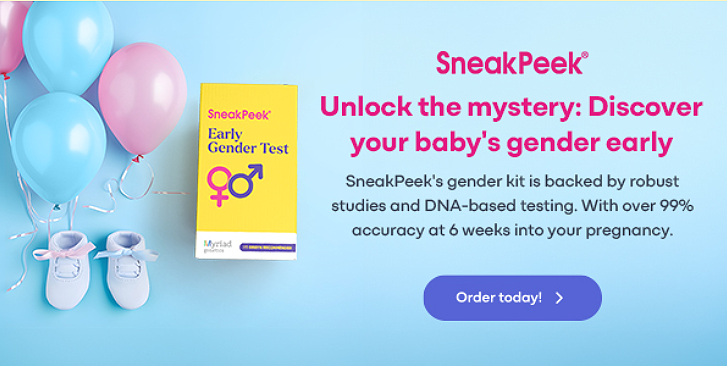Published on April 26th, 2025 and Updated on August 7th, 2025
Check out SneakPeek Gender Test to find out your baby’s gender as early as 6 weeks with over 99% accuracy!

Pregnancy tends to amplify all of your emotions: the warm and fuzzies, the butterflies, and the uncertainties, too.
Luckily, there’s at least one thing you don’t have to feel uncertain about: your baby’s sex. That’s because today’s blood tests can predict your baby’s sex with overwhelmingly accurate results. In fact, the SneakPeek Early Gender DNA Test® is proven to be over 99% accurate.
But you may hear a little voice in the back of your head asking, “What about the remaining less than 1%? Can a gender blood test be wrong?”
Keep reading to learn about factors that can potentially produce inaccurate blood test results and how to avoid them, ensuring you receive clear and speedy certainty when you need it most.
What can cause a gender prediction blood test to be wrong?
The SneakPeek Early Gender DNA Test® is inaccurate less than 1% of the time—but what does that tiny fraction encompass? In rare cases, biological factors—such as a vanishing twin or residual male DNA from a prior pregnancy—may affect results. However, inaccurate or inconclusive outcomes are typically related to the following factors.
Testing Too Early in Pregnancy
At-home gender prediction blood tests can predict your baby’s sex far sooner than your 20-week anatomy scan. With the SneakPeek test in particular, you can find out your baby’s predicted sex as early as 6 weeks into pregnancy. (Sign us up!)
Despite this expedited route to learning your baby’s predicted sex, there’s still a short waiting period you have to honor for the sake of accuracy. Taking the test before the 6-week mark may produce inconclusive or inaccurate results. That’s because there may not be enough fetal DNA present yet to make a definitive prediction.
To ensure your eligibility before collecting your blood sample, confirm how far along you are by calculating your last menstrual period with the SneakPeak test eligibility calculator or with the help of a healthcare provider.
Sample Contamination & Handling Errors
Here’s a quick crash course on the exciting science behind baby sex prediction tests:
Gender blood tests predict the baby’s sex by screening your blood sample for Y chromosomes, which female DNA typically doesn’t contain.
- If Y chromosomes are absent, it means your baby’s sex is predicted to be female.
- If Y chromosomes are detected, their sex is predicted to be male.
So, these blood tests rely on your DNA’s information to predict your baby’s sex. However, this means that any contamination from male DNA could mess with your results (since the test screens for Y chromosomes).
If a male partner, sibling, or friend wants to help you collect your test sample, let them know that they can show their support by cheering you on from a safe distance.
Lab Processing Mistakes
Lab technicians are well-trained and highly experienced in conducting blood tests using your at-home sample. It’s their job, after all! That said, everyone is human. While human errors impact only a small fraction of test results, they do occur occasionally.
This doesn’t always mean you’ll receive a false result, though. Lab processing mistakes will likely cause an inconclusive test—which, in that case, you can simply collect and send another blood sample. (At SneakPeek, that retest is free of charge, by the way.)
A Note on the NIPT
Noninvasive prenatal testing, also known as the NIPT test, screens your fetus for the risk of chromosomal disorders such as Down syndrome. What’s more, it offers a great two-for-one deal: It can also predict their sex.
NIPT tests are highly accurate in detecting chromosomal disorders. But can NIPT be wrong for gender?
Like gender prediction blood tests (and any screening test for that matter), the NIPT has a tiny margin of error. Feel free to discuss NIPT results with your healthcare provider to alleviate any concerns you may have.
Not only does SneakPeek provide an early and highly accurate gender test, but we also offer additional support through Myriad Genetics® with their Prequel® test. This noninvasive prenatal screening test gives you valuable insights into your baby’s health, including potential risks, while providing a fuller picture as you prepare for your growing family. From your first peek at your baby’s sex to a comprehensive understanding of their health, we’re with you every step of the way.
How to Ensure the Most Accurate Gender Prediction Blood Test Results
The good news is that you have more control over your test’s accuracy than you may think. Follow these guidelines to celebrate your exciting discovery with total confidence.
Confirm Your Gender Prediction Blood Test Eligibility
Before ordering your sample collection kit, double-check that you meet the gestation period necessary for viable results. Keep in mind that different baby gender tests require different gestation periods. For SneakPeek, you can test as early as 6 weeks in gestation—less than two months!
SneakPeek clinical studies used the LMP calculator to determine that participants were 6 weeks pregnant and proved over 99% accuracy for our test.
If it’s good enough for science, it’s good enough for you! Confirm your eligibility using our simple LMP calculator.
What If I Have Irregular Cycles or PCOS?
The SneakPeek Test is most accurate when used at 6 weeks gestational age, based on a regular 28–30 day menstrual cycle. However, if your cycle is longer than average—such as 35–45 days—or if you have a condition like PCOS (polycystic ovary syndrome) or experience anovulatory cycles, ovulation may occur later than expected. This means you could take the SneakPeek Test before enough fetal DNA is present in your bloodstream, which may affect the accuracy of your results.
If your cycles are irregular or you’re unsure of your gestational age, it’s best to speak with your healthcare provider. In some cases, they may recommend confirming your due date with an ultrasound or waiting a little longer before using the SneakPeek Test to help ensure more reliable results.
Best Practices for Collecting Your Sample
When collecting your blood sample, it’s important to follow all instructions to ensure the most accurate results. Consider reading through the instructions before you begin the collection process so you feel completely confident and prepared. This will also ensure you have everything you need at the ready for the collection process.
Here are some other sample collection tips that can help alleviate any accuracy concerns:
- Wash your hands and wipe down your collection area thoroughly – Squeaky clean, dry skin and an equally clean collection area will help prevent potential contaminants from entering your sample.
- Fully incorporate the preservative solution – Once you’ve collected your sample and closed the tube, take time to gently distribute the preservative solution into every nook and cranny. Slowly rotate the tube, beginning upside down to right-side up, and repeat 10 times for the best results.
- Handle your sample with care – Your home isn’t as sterile as a doctor’s office or lab. That said, you can easily avoid potential contamination by following the instructions, keeping your area clean, and preparing and packaging your blood sample with gentle caution.
If you need help when collecting your sample, don’t stress the more the merrier! Just be sure the person who helps doesn’t have any Y chromosomes that could contaminate your sample.
Why SneakPeek® Is the Most Recommended Early Gender Test
Another way to ensure the most accurate results on your test? Choose a test company that practices precision and transparency every step of the way.
For that, there’s the SneakPeek baby gender test.
Our numbers speak for themselves: The SneakPeek Early Gender Test is the #1 OBGYN-recommended at-home gender test*—recommended 6 to 1 among 100 OBGYNs surveyed—and used by over 1 million happy parents.
Why do expectant parents and doctors alike choose SneakPeek again and again for noninvasive prenatal testing? Because our test works sooner—and more accurately—than any other.
Proven Accuracy & Scientific Validation
At SneakPeek, we don’t simply claim accuracy—we guarantee it.
SneakPeek has a total of nine clinical studies published in highly credible, peer-reviewed scientific journals. They’ve proven the SneakPeek gender test to be over 99% accurate just 6 weeks into pregnancy.
Where does this percentage come from? Let’s take a closer look at one study in particular, published in Clinics in Mother & Child Health:
- Out of 115 participants (who were 6 weeks pregnant at the time of the test), 113 received correct results on their baby’s sex.
- Only two participants received inconclusive results, meaning the test was unable to definitively determine their baby’s sex.
- No participants received false results.
In an even larger study following over a thousand pregnant people—the largest clinical study of its kind—only one test produced a false result, proving over 99% accuracy.
When it comes to the SneakPeek gender test, the odds of accuracy are in your favor. And if for any reason your results don’t match your baby’s sex, we’ll send you a full refund for your test, guaranteed.
How the SneakPeek Test Minimizes Testing Errors
Here’s how the SneakPeek test works to minimize testing errors and inconclusive results:
- Detailed instructions – We’ve eliminated all the guesswork from our at-home sample collection process with our crystal clear instruction booklet. It walks you through the entire process, from kit activation to mailing, with detailed guidance.
- All supplies included – No last-minute convenience store runs for gauze or alcohol wipes needed—the SneakPeek test comes with everything necessary to collect (and mail!) your sample.
- Patented Snap sample collection device – We’ve added yet another improvement to the gender blood test. The SneakPeek Snap® is an easier-to-use collection device that’s virtually painless (compared to a fingerstick).
We have your back. Always. If you ever have any questions about your sample, shipping, or results, feel free to reach out to our dedicated customer care team. We’re available Monday through Friday from 9am to 5pm PST.
What to Do If You Receive Unexpected Test Results
We’re so confident in our test that the SneakPeek test offers an accuracy guarantee. Again, if your baby’s sex doesn’t match your test results, you’ll receive a full refund. Period.
And on the very slim chance you receive inconclusive test results, we’ll send you a retest, free of charge. Or if you decide not to retest, we’ll send you a refund instead.
Know Sooner—and with More Certainty—with SneakPeek®
Blood tests offer an answer on your baby’s predicted sex weeks ahead of your 20-week ultrasound. But only the SneakPeek Early Gender DNA Test® provides over 99% accurate results just 6 weeks into your pregnancy.
Whether you’re itching to start researching intimate gender reveal ideas and dive into how to throw a gender reveal party, or you’re simply curious to know the sex of your baby, SneakPeek is committed to providing quick and accurate results so families can know early and love early. That’s a pretty big deal—and it’s why we’re the #1 test recommended by OBGYNs*, used by over 1 million parents.
Disclaimers:
*SneakPeek recommended six to one among 100 OBGYNs survey
Editorial Policy
At SneakPeek, our commitment is to provide accurate, up-to-date, and reliable information to empower our readers. Our content is thoroughly researched, reviewed by medical experts, and fact-checked to ensure its credibility. We prioritize the well-being and education of our readers, and our editorial policy adheres to the highest standards of integrity and accuracy in all our articles.
This post has been reviewed for accuracy by the following medical professional:
Dr. Stitt is a board-certified OB/GYN with over 20 years of experience providing compassionate care to women throughout every stage of pregnancy and childbirth. She is currently the medical director for a large group practice in Annapolis, Maryland and is actively involved in training both OB/GYN residents and medical students. Dedicated to patient education and empowerment, Dr. Stitt is passionate about helping women make informed decisions about their health, from prenatal care to postpartum recovery. Known for a warm and supportive approach, Dr. Stitt strives to create a positive and reassuring experience for expectant mothers, ensuring they feel confident and well-prepared for the journey of motherhood.
Sources:
- International Journal of Pregnancy & Child Birth. Large scale follow-up research study: SneakPeek® Early Gender DNA Test 99.9% accurate for fetal sex by live-birth confirmation. https://sneakpeektest.com/wp-content/uploads/2021/01/Large-scale-follow-up-research-study-SneakPeek-Early-Gender-DNA-Test-99.9-Accurate.pdf
- Clinics in Mother and Child Health. SneakPeek Early Gender Test: The Earliest and Most Accurate Method for Fetal Sex Determination at 6-Weeks Gestation. https://sneakpeektest.com/wp-content/uploads/2022/07/sneakpeek-early-gender-test-the-earliest-and-most-accurate-method-for-fetal-sex-determination-at-6weeks-gestation-ji.pdf
- SneakPeek. Test eligibility calculator. https://sneakpeektest.com/test-eligibility-calculator/
- Healthline. Finding Out Your Baby’s Sex Through a “Gender Blood Test”. https://www.healthline.com/health/pregnancy/blood-test-for-gender#at-home
- SneakPeek. Frequently asked questions. https://sneakpeektest.com/faqs/
- Cleveland Clinic. NIPT Test. https://my.clevelandclinic.org/health/diagnostics/21050-nipt-test
- SneakPeek. SneakPeek research roundup. https://sneakpeektest.com/gender-dna-science/
- NIH. The accuracy and feasibility of noninvasive prenatal testing in a consecutive series of 20,626 pregnancies with different clinical characteristics. https://pmc.ncbi.nlm.nih.gov/articles/PMC9550972/








